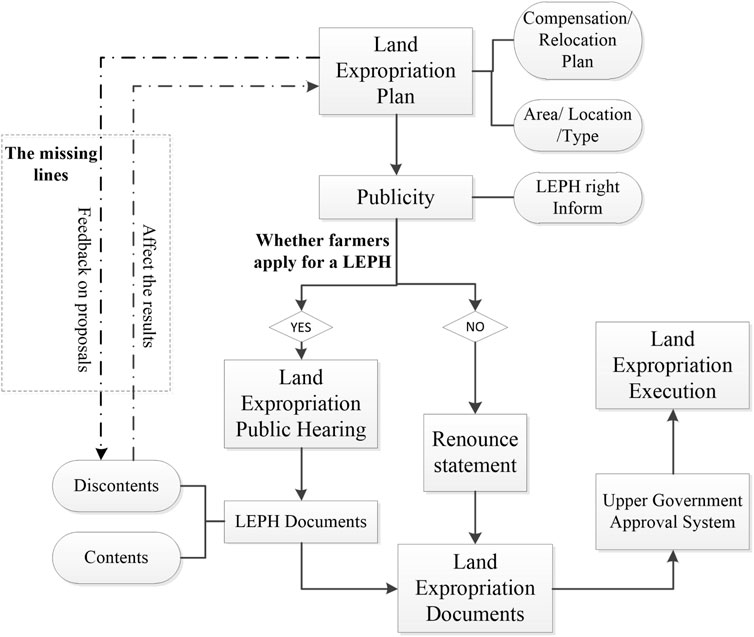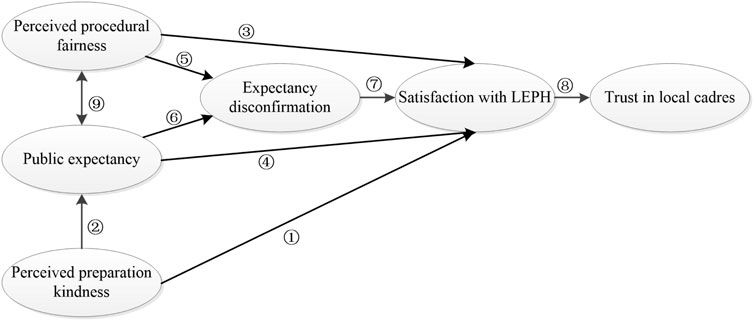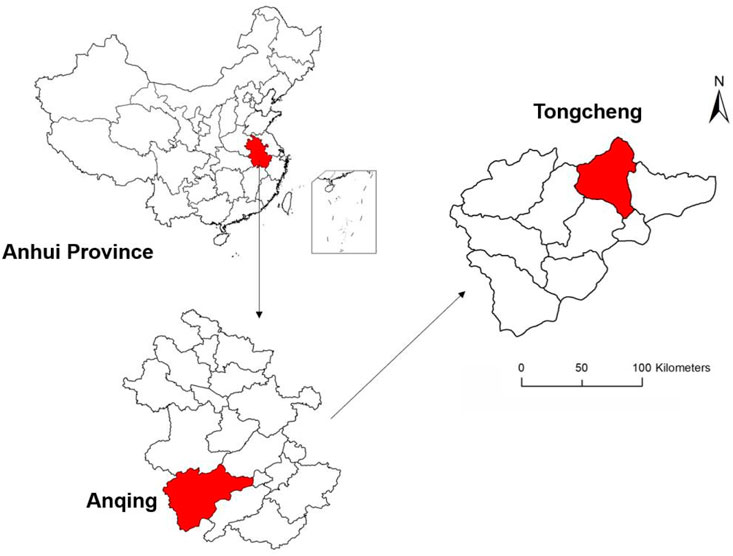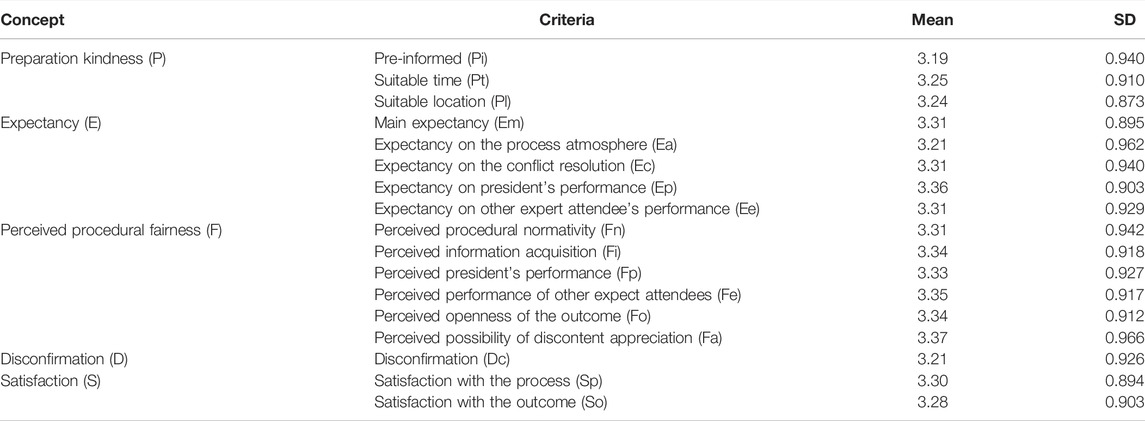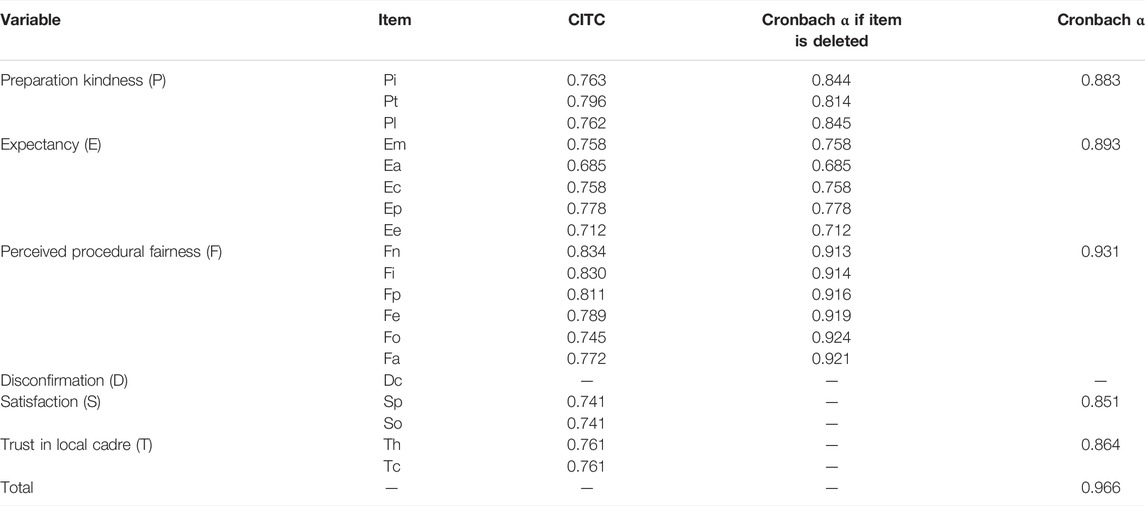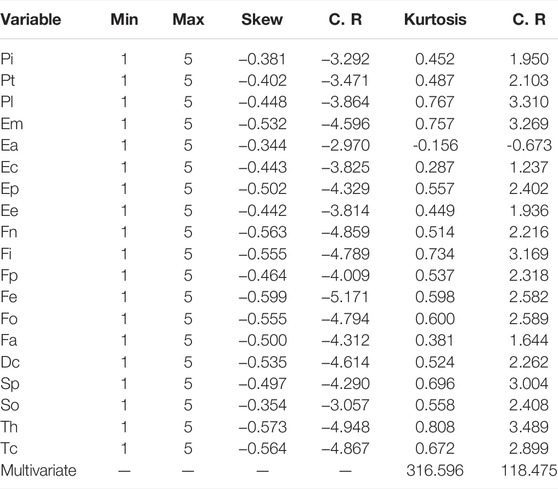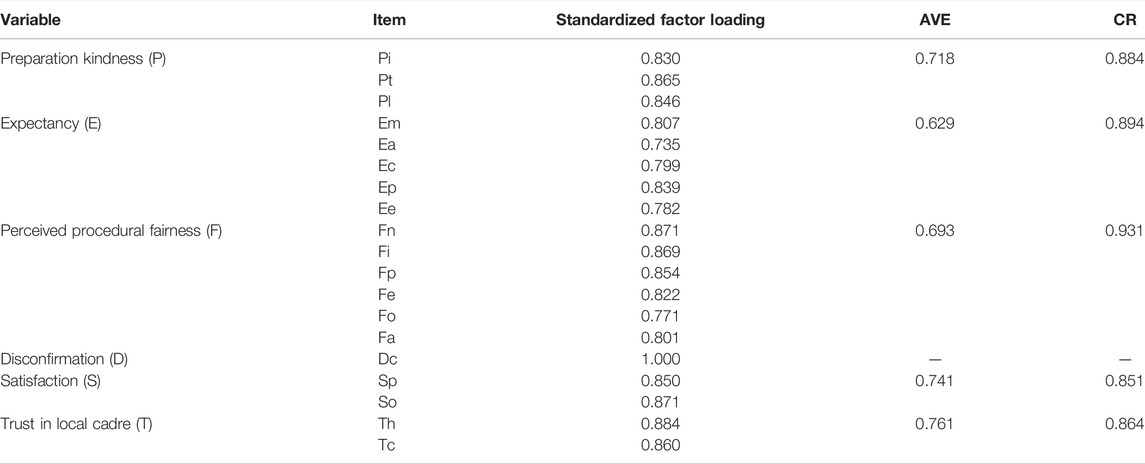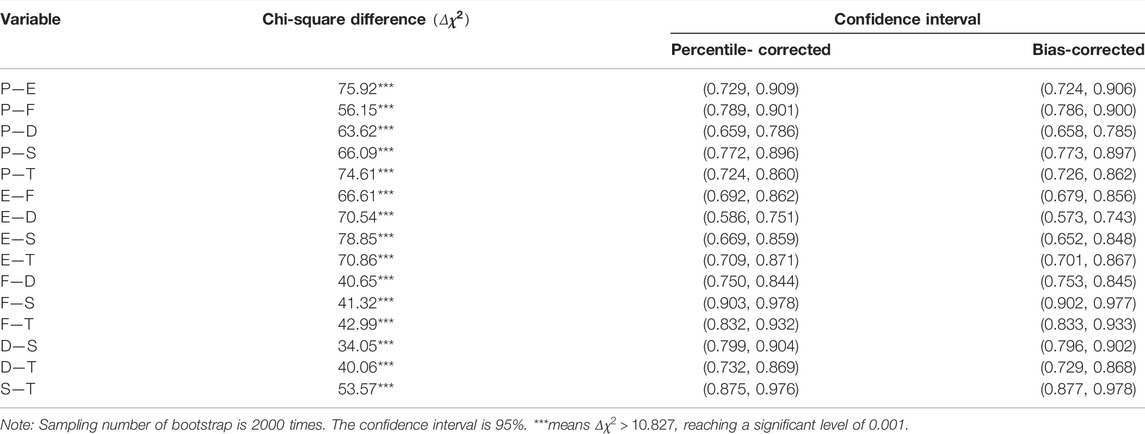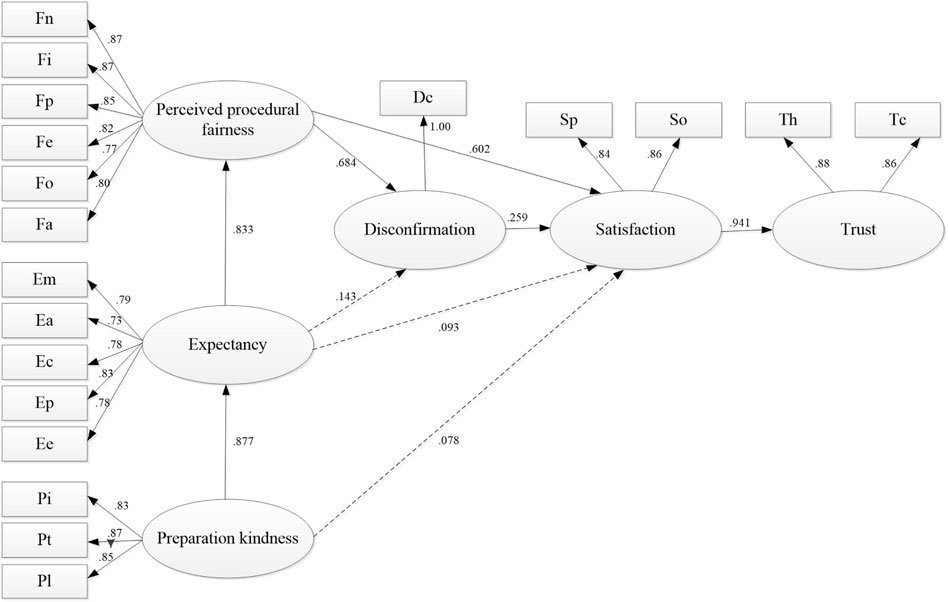- 1China University of Geosciences Wuhan, Wuhan, China
- 2Hubei Hongtai State-Owned Capital Investment Operation Group Co., Ltd., Wuhan, China
- 3Hubei University of Economics, Wuhan, China
- 4Collaborative Innovation Center for Emissions Trading System Co-constructed by the Province and Ministry, Wuhan, China
Although public hearings have been introduced into Chinese land expropriation as an important democratic supervision and conflict resolution mechanism for more than 15 years, there is a dearth of research into its qualities. Taking the farmers’ satisfaction with the public hearings as the critical quality indicator, this article analyzes the dilemma of this special institution in Chinese land expropriation. Process tracing is employed to analyze the design defect of the public hearing institution. Farmers’ satisfactions with the public hearings are measured by a questionnaire, and the factors are examined by a structural equation model based on the theories of expectancy disconfirmation and procedural fairness. It is concluded that the distorted procedure and the inconsiderate arrangement affect farmers’ perceived procedural fairness and decrease their satisfaction with hearings. In order to solve the dilemma of public participation in land expropriation, the relevant authorities should start from the source of affecting farmers’ satisfaction.
1 Introduction
Chinese massive land expropriations have caused numerous social conflicts (Lin et al., 2018; Wang et al., 2019; Xie, 2019; Zhou, 2020; Nanhthavong et al., 2021). Reasons of these conflicts refer to insufficient compensation (Qian, 2015), inequity of the compensation allocation (Tong et al., 2017), illegal expropriation (Wu & Heerink, 2016), corruption of the local cadre (Song et al., 2016), and the absence of democratic supervision and conflict management mechanism (Zhou & Banik, 2014). Public participation is often assumed an effective tool in environmental and natural resources and NIMBY conflict management (Elliott & Kaufman, 2016; Sun et al., 2016; Xie et al., 2017). Public participation has been increasingly promoted in China over the past 3 decades (Gu, 2016). Public hearing, or public meeting, a primary mechanism of public participation, was introduced into China in 1996 (Yang, 2003). Public hearing promoted the political efficacy and deliberative democracy in China (Zhang, 2013; Ergenc, 2014), so it was more appreciated in the construction of the rule-of-law government. The Chinese Ministry of Land and Resources (MLR) enacted the Provision on the Hearings in Respect of Land and Resources (PHRLR) in 2004, which included the Land Expropriation Public Hearing (LEPH). LEPH was designed as an integrated platform of information collection, mutual communication, and down-top supervision at the preliminary stage of land expropriation. Central reformers expected to reduce the illegal expropriation and the social conflicts by improving the procedure transparency and providing farmers a new formal channel to express demands. However, there is a dearth of research into its qualities.
As the symbol of deliberative democracy, public participation is widely employed into contemporary governance (Fung, 2006; Webler et al., 2001). Despite its popularity, most techniques used in participation are inadequate, especially the public hearing, which is always associated with low attendance and low satisfaction (King et al., 1998). Several dilemmas militate against the practice and development of public participation (Rowe & Watermeyer, 2018). There is an urgent need to evaluate the quality of participation (Rowe & Frewer, 2000). In spite of the rapid development in China, the effectiveness of public participation is questioned (Enserink & Koppenjan, 2007). Criteria to evaluate the effectiveness of participation may include comfort, convenience, satisfaction, and deliberation (Halvorsen, 2001; Welch et al., 2004). Satisfaction is an outcome criterion (McComas, 2003). Satisfaction of the participant in natural resource management, project construction, and risk communication is measured (McComas, 2003; Li et al., 2013). A more comprehensive understanding of how the process and outcome criteria relate to participants’ satisfaction is an important next step to a more robust public hearing theory (McComas, 2001).
LEPH is the only formal public participation method in Chinese land expropriation. The mass incidents stemming from land expropriation have declined the political trust in rural China (Cui et al., 2015). Re-strengthening farmers’ trust in the local government is among the purposes of central government’s promotion of participation in land expropriation. The possible relationship between satisfaction and trust in the government (Christensen & Lægreid, 2005) prompts us to evaluate the participation in Chinese land expropriation by farmers’ satisfaction with LEPH and to examine the factors of the satisfaction. The structure of the research is as follows. First, an overview of the procedure of LEPH with the process tracing method to identify the design defect of the hearing institution is presented. Second, the theory framework of participants’ satisfaction is formulated. Then, data and results are analyzed deeply. Last but not the least, the discussion and conclusion are given.
2 Overview of Land Expropriation Public Hearing
Responding to the intense criticism on the transparency of the decision-making and the political demands of the rule-of-law government, MLR introduced several public hearings into land management, including price hearing, legislation hearing, administrative penalization hearing, administrative licensing hearing, and LEPH. Most of these hearings had a relatively successful pilot, except LEPH. All these hearings were divided into categories, hearings organized in accordance with the power of the competent authority (HOP), and hearings organized at the application by a party concerned (HOA). LEPH belongs to the HOA, which means it will be organized at the application by land-expropriated farmers before the county land management department submits the expropriation compensation and relocation plan to a higher authority for approval. There are significant differences among these hearings, including the interests related, the scale and heterogeneity of the stakeholders, and the relationship among the public and authorities. All these hearings were hastily packed into the PHRLR, without careful consideration of the differences. This article argues there is a distortion in LEPH’s procedure design, which leads to the disconfirmation of farmers’ expectancy and decreases their satisfaction with LEPH. Process tracing, a within-case method aiming at the discovery and validation of a causal mechanism, is employed here to analyze the procedure distortion (Kay & Baker, 2015).
Land expropriation provides large-scale new construction land to Chinese urbanization each year. The County Land Bureau is the only executor of land expropriation. MLR has employed a complicated approval system to monitor and restrain local land expropriation by a strict control of the new construction land quota. The quotas are extremely scarce, and the priority of quota allocation is a sophisticated political issue. In order to make full use of the scarce quota, the land expropriation is project-oriented. Several important pre-work should be finished before the bureau makes an expropriation plan, including project investment confirmation, feasibility study, environmental impact assessment, and location. After an expropriation investigation and result confirmation, the bureau publicizes the plan of land expropriation compensation and relocation, which always includes two parts: 1) the area, location, and type of the lands which are planned to be expropriated and 2) the compensation standard of the land and the relocation standard of the land-lost farmers. This plan is the start point of the LEPH (shown in Figure 1), and part 2 is the main content heard in the LEPH.
At the end of the publicity, stakeholders are informed that they have the right to apply for an LEPH in maybe 5–7 days after the publicity date; otherwise, they are asked to confirm a renounce statement. If an LEPH is applied, the bureau will organize the hearing at an appropriate time and place. Participants always include the president, hearing officers, the clerk, the applicants (land-lost farmers), and the respondents (land expropriation officers). The hearing shall proceed in accordance with five steps: president’s starting announcement, applicants’ inquiries and opinion presentation, respondents’ reasons and proof presentation, final statements, and president’s ending announcement. All the presentations of farmers and officers, content and discontent, are recorded into the documents. Hearing documents, or renounce statements, are packed into the approval volume, submitting to the higher department. These procedures of LEPH are illustrated by the solid lines in Figure 1. However, there are some important lines missed in the procedure design.
According to Rowe and Frewer (2000), public participation encompasses a group of procedures designed to consult, involve, and inform the public of allowing those affected by a decision to have an input into that decision. The input and output procedures are critical to the success of the participation. Many researchers criticize those participations without substantial impact on decision-making as rhetoric (Conrad et al., 2011; Bawole, 2013). It is suggested factors of an authentic participation include constructive feedback on proposal and follow-up communication (King et al., 1998; Manowong & Ogunlana, 2008); meanwhile, participants may reciprocate negatively if they are consulted but ignored (Corgnet & Hernán-González, 2013).
The national provision PHRLR requires hearing documents as an attachment of land expropriation approval volume, without any details about the effect of discontents on the expropriation plan. Several training documents on the construction land approval procedure are released by prefectural land management bureaus, and there is neither any requirement on plan adjustment. Higher authorities approve the plan on the completeness and legality of these documents. The LEPH is designed by authorities as an informative hearing (Heberlein, 1976) or the hearing to satisfy legal requirements for public participation (Checkoway, 1981). However, the participants are trying to be heard, not to do hearing (Conrad et al., 2011; Bawole, 2013; Corgnet & Hernán-González, 2013). So from the perspective of the participants, there are some missing procedures in the institutional design of the LEPH, represented by the dashed lines in Figure 1. Land expropriation compensation and relocation involve many authorities, including the bureaus of land management, social security, urban planning, forest management, environmental protection, and the village committee and groups. Numerous disagreement and differences of opinion on the compensation and relocation plan will emerge. Respondents of the LEPH are always limited to the expropriation officers in the bureau of land management. They cannot respond farmers’ inquiries constructively, considering the null effect of the hearing details on the expropriation approval. Prevarication is adopted as the strategy to respond to the farmers’ concern, which will aggravate the farmers and degrade their experience of the participation. The immanence limitation to the procedure, the complexity of land expropriation compensation and relocation, and the unamiable responses of the authorities crash the system and dissatisfy participants together.
3 Theory Framework
Research studies examining the participants’ attitudes toward public participation and their factors are notably absent (McComas, 2003). Ogunlana et al. (2001) examined the public hearing on a construction project in Thailand and identified several factors dissatisfying participants. Based on group communication, McComas (2003) identified expectations, informational communication perception, interest perception, and agency credibility as the underlying factors of participants’ satisfaction. In another work, McComas et al. (2007) examined the relationship among perception of procedural fairness, participant’s stake in outcome, satisfaction with meetings, and the outcome acceptance. Based on these rare explorations and the referable research results in communication satisfaction, we tried to model the satisfaction with the LEPH on two important theories including expectancy disconfirmation and perceived procedural fairness.
Originating in the study of consumer satisfaction (Oliver et al., 1994), expectancy disconfirmation (EDM) has emerged as the predominant model of satisfaction with public services (Van Ryzin, 2013; Petrovsky et al., 2017). The theory assumes that citizen satisfaction is the result of the comparison between expectancy and perception of performance or expectancy disconfirmation. There are three important links in EDM, which are illustrated in Figure 2: direct impact of performance perception on satisfaction, direct impact of expectancy on satisfaction, and impact of the interaction between performance perception and expectancy, named disconfirmation, on satisfaction (Figure 2).
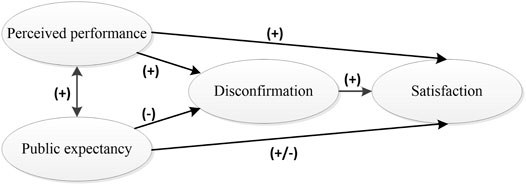
FIGURE 2. Expectancy disconfirmation model (Van Ryzin, 2013)
We extended the EDM at three points. First, we used the perceived procedural fairness as the perceived performance. Based on the works of Thibaut & Walker (1975) and Tyler (1989), McComas et al. (2007) examined the impact of perceived procedural fairness on participants’ satisfaction and outcome acceptance with advisory committee meetings, another important participation method. They argued that people cared much about the fairness of the decision-making procedure because it symbolized whether they are respected. Other research studies prove similar impacts of procedural fairness on citizens’ satisfaction with the government (Herian et al., 2012).
Second, we added in the link from farmers’ satisfaction to their trust in local cadres. Many researchers argued that Chinese people had more trust in the central government than in local cadres (Zhong, 2014). Tense relationships between farmers and local cadres exacerbate the rural unrest in China. The Chinese central government has launched a series of reformation to rebuild the local political trust, such as the village election and rule-of-law government. This purpose is also embedded into the introduction of public participation in China.
Third, considering the frequent emphasis on the critical function of good preparation to a successful public hearing (Manowong & Ogunlana, 2008), we included the perceived preparation kindness into the model. A considerate preparation, such as a suitable time and location, will improve the relationship between the authority and farmers (Figure 3).
Some hypotheses are presented as follows based on the aforementioned facts:
Hypothesis 1. Perceived preparation kindness of the hearing will directly predict farmers’ satisfaction with the LEPH.
Hypothesis 2. Perceived preparation kindness will predict the farmers’ expectancy on the hearing.
Hypothesis 3. Perceived procedural fairness will directly predict satisfaction.
Hypothesis 4. Farmers’ expectancy will directly predict satisfaction.
Hypothesis 5. Higher perceived procedural fairness will increase disconfirmation.
Hypothesis 6. Higher expectancy on hearing will decrease disconfirmation.
Hypothesis 7. Farmers’ expectancy disconfirmation will directly predict satisfaction.
Hypothesis 8. Farmers’ satisfaction will directly predict their trust in local cadres.
Hypothesis 9. There is a positive correlation between expectancy and the perceived performance in such an observational study, the causal direction is typically not specified (Van Ryzin, 2013).
4 Data and Results
4.1 Data
4.1.1 Study Area
We purposely chose Tongcheng city in Anqing Prefecture, Anhui Province as the study area (Shown in Figure 4). Significant heterogeneities are widely recognized in Chinese economic, social, and administrative issues, so the main principle for us to choose the study area is avoiding the extreme sample. First, according to the post-evaluation of PHRLR sponsored by MLR in 2012, Anhui province was in the medium position at the development and implementation of LEPH. Second, Anhui is also in the medium position at the frequency of the land-expropriation conflict (Lin et al., 2018). Third, the total GDP of Anhui is ranked the middle level in China, 13th out of 31 provinces in 2017. Tongcheng is an ordinary county-level city in Anhui at economic development, social stability, and administrative performance in the Anhui land management system (Figure 4).
4.1.2 Questionnaires
Land-expropriated farmers who did and did not attend the hearing were all interviewed for two reasons. The low application and attendance rate of LEPH is a national problem, according to the post-evaluation of PHRLR, so the cost to find enough attendees is too high. More importantly, McComas (2003) had testified in her research that irrespective of whether respondents had ever attended a public meeting, their satisfactions can be predicted. Twenty-six questions are asked to get to know the basic information of the respondents, such as the sexual status, age, education level, employment status, family populations, family monthly income, and proportion of land expropriated. Farmers’ perceived preparation kindness is involved which contains whether they are informed sufficiently before the hearing and whether the time and location of the hearing are suitable for them. Then, farmers’ expectancy on the process atmosphere, outcome of interest conflict resolution, performance of the president, and performance of other expect attendees are questioned. Later, it refers to farmers’ perceived hearing performance of hearing. Farmers are asked to evaluate the normativity of the process, the performance and neutrality of the president and other expect attendees, the openness of the outcome, and whether they have got the information they wonder. Farmers are also asked to evaluate whether their discontents on the hearing will be appreciated by relative authorities.
Farmers’ expectancy disconfirmations are measured as subjective. Disconfirmation can be measured either as subtractive or subjective (Petrovsky et al., 2017). Farmers are asked how well the hearing is performed relative to what they expect. Farmers’ satisfactions with the LEPH are measured by satisfaction with the process and satisfaction with the outcome, according to the evaluation criteria classification suggested by McComas (2003). At the end of the questionnaire, farmers are asked whether they trust in local cadres and LEPH. All variables, except the first seven questions on basic information, were measured with a 5-point Likert-type scale (1 = strongly disagree/dissatisfy and 5 = strongly agree/satisfy). With the help of the Bureau of Land Management of Tongcheng city, we located 14 villages with land-expropriation in recent 5 years. A total of 447 of 600 questionnaires distributed to farmer families were returned.
4.2 Results
4.2.1 Descriptive Analysis of Main Variables
The mean value and standard deviation of main variables are shown in Table 1. Farmers’ satisfaction with the process of the LEPH is 3.30 (SD = 0.894), slightly higher than the satisfaction with the outcome of the LEPH, 3.28 (SD = 0.903). These mediocre evaluations show that respondents tended not to be overly satisfied with public hearings as a way of involving themselves into the land expropriation procedures.
The highest result in Table 1 is the perceived possibility of discontents appreciated by authorities (3.37), which means farmers take LEPH as a formal channel to express discontents and attract authorities’ attention. However, the authorities introduced the LEPH as an informative technology, as mentioned earlier at the end of part 2. So, a mismatch appeared.
The lowest results include the three criteria of perceived preparation kindness, the expectancy of the atmosphere, and the disconfirmation. Farmers argued they were not well pre-informed by the authorities on the plan, the documents, and other information on the land-expropriation. Time and location of the LEPH were decided for the authorities’ convenience. Low expectancy on the process atmosphere means that a considerable proportion of respondents predicted conflictive arguments during the hearing. Twenty-four respondents (5.4%) firmly predicted there would be a quarrel during the hearing, and 67 (15%) predicted less firmly. Disconfirmation also had a lower value, illustrating farmers’ disappointment on LEPH.
4.2.2 Reliability Analysis
The purpose of reliability analysis is to evaluate the stability and internal consistency of the overall questionnaire and the measurement items of each latest variable. As shown in Table 1, we chose 19 observable variables to measure the six latest variables. Cronbach α coefficient and split half reliability are commonly used to test reliability in the Likert-type scale, and α coefficient is better than the half method. The higher the reliability of a scale, the more stable it is (Crocker & Algina, 1986). In multiple item scales, intrinsic reliability is particularly important. It not only measures whether each scale measures a single construct but also evaluates the internal consistency of the items in the scale. Cronbach α coefficient is one of the internal consistency coefficients. If Cronbach α is above 0.80, it indicates that the scale has a high reliability. Nunnally and Bernstein (1994) think that the criteria of reliability are different between exploratory research and confirmatory research. The lowest standard of the value of the credit coefficient in exploratory research is above 0.50, and it is better to be above 0.6. The best value of the credit coefficient in confirmatory research is above 0.80, and it is better to be above 0.9. Different scholars have different opinions on the minimum reliability coefficient. Some scholars think that it is acceptable to be above 0.80 (Gay et al., 2009). Some think that it is acceptable to be above 0.7 (Nunnally & Bernstein, 1994). When the reliability is not good, the item will be deleted. The criteria of item deletion or retention are the size of corrected item total correlation (CITC) and whether deletion of item improves Cronbach α (Parasuraman et al., 1988). The higher the CITC, the higher is the internal consistency between the item and other items in the same construct. Generally, items with CITC less than 0.30 should be deleted. We used SPSS 19.0 to test the reliability of the overall questionnaire and each late variable, and the results are shown in Table 2.
The Cronbach α coefficient of the overall questionnaire and all dimensions were greater than 0.80, which exceeded the minimum standard of each scholar and showed high reliability. Deleting any item will lead to the decrease in the corresponding Cronbach α, indicating that each construct item represents the same late variable uniformly, and no item is deleted.
4.2.3 Confirmatory Factor Analysis
Compared with exploration factor analysis (EFA), confirmation factor analysis (CFA) focuses more on the relationship between observable variables and latent variables (Everitt & Dunn, 2001). CFA is a pre-step or infrastructure for integrating structural equation modeling (SEM) analysis (Kline, 2015. We used the structural equation modeling method to study the factors that affect the satisfaction of landless farmers to LEPH. SEM is a kind of statistical modeling technology. It uses the measured model and structural model to test the hypothesis relationship between the observable variable and late variable and finds out the potential and interactive causal variables. The most commonly used parameter estimation method in SEM is maximum likelihood (ML). ML estimation has two basic assumptions: 1) the data conform to multivariate normal distribution and 2) the data are large sample data. Under this premise, the parameter estimation of ML will be asymptotically efficient unbiased, consistent, and effective (Schumacker & Lomax, 2004). Amos 21.0 is used to test the multivariate normality of the sample data in this study, as shown in Table 3. Under normal distribution, the skew coefficient and kurtosis coefficient should be close to 0. If the absolute value of skew coefficient is greater than 3 and kurtosis coefficient is greater than 8, it indicates that the data distribution may not be normal. If the absolute value of kurtosis coefficient is greater than 20, it indicates extreme kurtosis. If the multivariable kurtosis critical ratio (CR) is greater than 1.96, it indicates that the multivariable is non-normal. In Table 3, the skew coefficients of 19 observable variables are between −0.599 and −0.344, the kurtosis coefficients are between −0.156 and 0.808, and the absolute values of skew coefficients and kurtosis coefficients are less than 1, indicating that the single variable is in normal distribution. However, the multivariate kurtosis criticality ratio is far greater than 1.96, and multivariate distribution is typical non-normal distribution. Non-normal distribution of sample data will lead to overestimation of overall model fitting and underestimate of the standard error (SE) of partial parameter estimation. The bootstrap method can effectively deal with non-normal data and solve the estimation deviation caused by non-normal data (Bollen and Stine, 1992). This article will take this method for further research.
The measurement models of six constructs and 19 explicit variables were constructed by using the confirmation factor analysis. The bootstrap method is used to improve the accuracy of ML estimation of the chi-square value and standard error of the measurement model. Three kinds of goodness-of-fit indexes are used to measure the whole model. Table 4 shows the goodness-of-fit results of the CFA measurement model and the goodness-of-fit evaluation criteria proposed by scholars (Hair et al., 2010). The results showed that the CFA measurement model achieves the ideal goodness of fit.
After the overall evaluation of the measurement model, the validity between the observable variables and the latest variables measured is tested by the confirmation factor analysis. The validity of academic research can be divided into the content validity, criterion related validity, and construct validity. In practical operation, the content validity and criterion-related validity often require qualitative research by experts or recognized criterion measurement. In the past, few scholars have measured them, while the construction validity can be measured by confirmation factor analysis. Construction validity consists of conversion validity and discriminative validity. Convergent validity reflects the degree to which observable variables evaluate their latent variables, that is, the problem of measuring circumference. Discriminative validity reflects the degree to which one latent variable differs from the other, that is, the problem of measuring exclusivity (Hair et al., 2013). Conversion validity can be measured from factor loading, average variance extracted (AVE), and construct reliability (CR). The standardized factor loadings of observable variables should be higher than 0.50, and the ideal state should be higher than 0.70. AVE should be greater than 0.50. CR should be greater than 0.7, which indicates that the model has good conversion validity (Hair et al., 2010). The standardized factor loading of observable variables and the AVE and CR indexes of late variables are shown in Table 5. It is obvious that factor loading, AVE, and CR all meet the standards, and the conversion validity of the model is good.
In AMOS operation, the chi-square difference test is generally used to identify the significance of chi-square difference (Bagozzi and Phillips, 1982). Further supplementary evaluation of discriminative validity is made by confirming that the confidence interval of two construct correlation coefficients does not contain 1 (Torkzadeh et al., 2003). The chi-squared difference test is carried out for two combinations of six latent variables. The chi-squared difference between the restricted model and the unrestricted model is listed in Table 6. Obviously, all the unrestricted models are significantly smaller. Using Bootstrap to calculate the confidence interval of the correlation coefficient between latent variables, we further proved the discriminative validity. From Table 6, we can see that the confidence intervals of percentile corrected and bias corrected do not contain 1. The two tests fully show that the discriminative validity of each construct is high.
4.2.4 Structural Equation Modeling Results
After confirmatory factor analysis, the structural equation modeling is constructed according to Figure 3, which assumes that there are significant causal relationships among the six latent variables, namely, preparation kindness, public expectation, performed procedural fairness, farmers’ expectation unconformity, farmers’ satisfaction, and trust in local cadres. SEM can deal with the complex hypotheses among multiple latent variables easily and intuitively and verifies the hypotheses by calculating path coefficients to test the causal relationship of latent variables. With the help of Amos 21.0, bootstrap is applied to improve the accuracy of ML estimation, and the standardized structural equation model of Figure 5 is obtained, in which the sampling number of bootstrap is 2000 times (Figure 5).
When the structural equation model is fitted,
Table 8 shows the validation results of causality between underlying variables of bootstrap ML estimation. In the case of non-normal distribution of data, using ML estimation may lead to the statistical significance of the estimated value of the parameter. Taking the path “expectation” to “unconfirmation” as an example, under ML estimation, p = 0.028 < 0.05. In other words, the path is significant at p = 0.05. However, under bootstrap percentage correction, p = 0.055 > 0.05. This path is not significant. It can be seen that the research proves the ability of the bootstrap to correct the ML estimation of non-normal data. According to Table 8, the p-values of H1, H4, and H6 standardized estimates are 0.399, 0.366, and 0.055 (>0.05), respectively, indicating that H1, H4, and H6 are not significant at the significance level of 0.05 and above. In Figure 5, the empirical results are represented by full lines and dashed lines, respectively. The solid line indicates that the path is significant at the level of 0.001, while the dotted line indicates that the path is not significant. In other words, except H1, H4, and H6, all assumptions are significant.
5 Discussion and Conclusion
By expanding the theory of expectation failure, this article puts forward a theoretical model based on the hearing satisfaction of the farmers whose land is expropriated and determines the influencing factors of the satisfaction, in order to solve the dilemma of public participation in land expropriation. The results showed that those hypotheses presented are not all significant. The findings of the study will be discussed as follows.
First, perceived preparation kindness can effectively predict farmers’ expectations for hearings (H2). Public expectancy is “willing expectation,” but not “real expectation.” It is affected by the public’s own needs, the information in various aspects learned in the early stage and the public’s experience of word-of-mouth. In other words, if the perceived preparation kindness of farmers is low, then the public with learning ability will reduce their expectations rationally. Public expectancy has a positive effect on perceived procedural fairness (H9). This result also fits well with the conceptual basis of the American Customer Satisfaction Index (ACSI) (Fornell et al., 1996). Expectancy has an assimilation effect on perceived procedural fairness. Furthermore, perceived procedural fairness can directly predict satisfaction (H3). If there are standardized hearing procedure design, neutral and professional host and experts, the landless farmers with required information, open and transparent hearing results, and the dissatisfaction and opinions expressed by the farmers at the hearing can be valued by the government authorities; then, the farmers will have perceived procedural fairness, resulting in a high degree of satisfactory.
Second, perceived procedural fairness has a positive effect on disconfirmation (H5). This shows that higher perceived procedural fairness will increase the positive test failure. However, the direct effect of public expectation on disconfirmation is not significant (H6), and the direction is positive (
Third, the direct impact perceived preparation kindness and public expectancy on satisfaction are not significant (H1 and H4). This may be related to the distortion of the hearing procedure design and information asymmetry. Although the hearing on land acquisition is proposed to the land and resources department by the peasants who have been expropriated, the peasants seem to be the initiator of the hearing. Because the peasants are in a weak position of lacking information, the government is still the leader of the hearing on land acquisition. The compensation and resettlement of land acquisition involves many departments, and the information interaction between them is not smooth. In addition, the government officials with limited rationality have self-interest in policy formulation and implementation (Linping, 2010). In order to protect the interests of their own departments, they will selectively disclose information and conceal information that is not good for them. These factors directly lead to the information asymmetry of the hearing subjects. Therefore, although the government has made good preparation for the hearing of land acquisition, the farmers get sufficient information before the hearing. Due to the asymmetry of information, the farmers cannot identify the effectiveness of information in the hearing process and cannot predict the specific policy behavior of policy makers and executors effectively in advance. Farmers’ perceived preparation kindness and expectancy will only directly increase the possibility of farmers’ public participation. Because of the unknown implementation of the land acquisition hearing process, farmers are not sure that good perception and expectations before the meeting can directly lead to a satisfactory outcome.
Fourth, in order to explore the total impact of each antecedent of satisfaction on satisfaction, we also used Bootstrap to analyze the mediating effect of the model. The results showed that each intermediate variable in the model is significant at the level of 0.01. The direct effect of perceived procedural fairness on satisfaction was 0.602. The indirect effect is 0.177, and the total effect is 0.779. Perceived procedural fairness plays a completely mediating role in expectancy and disconfirmation. The effect value is 0.570. The direct effect of expectancy on satisfaction is not significant. But perceived procedural fairness can indirectly affect text failure so as to affect satisfaction. The total indirect effect is 0.148. Perceived preparation kindness has no significant direct impact on satisfaction. Satisfaction can be indirectly affected by expectancy, perceived procedural fairness, and text failure.
Finally, results mentioned previously show that the four antecedents of satisfaction can directly or indirectly significantly affect satisfaction, and farmers’ satisfaction directly determines their trust in the local government (H8). Therefore, in order to solve the dilemma of public participation in land expropriation, the relevant authorities should start from the source of affecting farmers’ satisfaction and effectively manage conflicts. For example, the relevant authorities could communicate fully with those farmers to get to know their real needs and inform them in advance about some relevant policies. At the same time, more participation of the farmers also could facilitate the land expropriation (Webler et al., 2001; Welch et al., 2004; Kline, 2015; Xie et al., 2017).
Data Availability Statement
The original contributions presented in the study are included in the article/supplementary material; further inquiries can be directed to the corresponding author.
Author Contributions
Conceptualization, TT; methodology, LS and QL; validation, FZ and RQ; writing—original draft preparation, LJ.
Funding
This study was financed by the National Social Science Fund Project of China (14CKS014) and the Humanity and Social Science Fund of Chinese Ministry of Education (12JYC630153; 17JYC630028; 17YJC790122; 21YJC630074).
Conflict of Interest
Author LJ was employed by the company Hubei Hongtai State-Owned Capital Investment Operation Group Co., Ltd.
The remaining authors declare that the research was conducted in the absence of any commercial or financial relationships that could be construed as a potential conflict of interest.
Publisher’s Note
All claims expressed in this article are solely those of the authors and do not necessarily represent those of their affiliated organizations, or those of the publisher, the editors, and the reviewers. Any product that may be evaluated in this article, or claim that may be made by its manufacturer, is not guaranteed or endorsed by the publisher.
Acknowledgments
We are particularly thankful to farmers in Tongcheng who kindly responded the survey and officers of the Bureau of Land Management and other departments of Tongcheng City who kindly helped us locate the research area and sent questionnaires.
References
Bagozzi, R. P., and Phillips, L. W. (1982). Representing and Testing Organizational Theories: A Holistic Construal. Adm. Sci. Q. 27, 459–489. doi:10.2307/2392322
Bawole, J. N. (2013). Public Hearing or 'Hearing Public'? an Evaluation of the Participation of Local Stakeholders in Environmental Impact Assessment of Ghana's Jubilee Oil Fields. Environ. Manag. 52 (2), 385–397. doi:10.1007/s00267-013-0086-9
Bollen, K. A., and Stine, R. A. (1992). Bootstrapping Goodness-Of-Fit Measures in Structural Equation Models. Sociol. Methods & Res. 21 (2), 205–229. doi:10.1177/0049124192021002004
Checkoway, B. (1981). The Politics of Public Hearings. J. Appl. Behav. Sci. 17 (4), 566–582. doi:10.1177/002188638101700411
Christensen, T., and Lægreid, P. (2005). Trust in Government: The Relative Importance of Service Satisfaction, Political Factors, and Demography. Public Perform. Manag. Rev. 28 (4), 487–511. doi:10.1080/15309576.2005.11051848
Conrad, E., Cassar, L. F., Christie, M., and Fazey, I. (2011). Hearing but Not Listening? A Participatory Assessment of Public Participation in Planning. Environ. Plann C Gov. Policy 29 (5), 761–782. doi:10.1068/c10137
Corgnet, B., and Hernán-González, R. (2013). Don’t Ask Me if You Will Not Listen: The Dilemma of Consultative Participation. Manag. Sci. 60 (3), 560–585. doi:10.1287/mnsc.2013.1786
Crocker, L., and Algina, J. (1986). Introduction to Classical and Modern Test Theory. New York, NY: Holt, 136–143.
Cui, E., Tao, R., Warner, T. J., and Yang, D. L. (2015). How Do Land Takings Affect Political Trust in Rural China? Polit. Stud. 63 (S1), 91–109. doi:10.1111/1467-9248.12151
Elliott, M. L., and Kaufman, S. (2016). Enhancing Environmental Quality and Sustainability through Negotiation and Conflict Management: Research into Systems, Dynamics, and Practices. Negot. Confl. Manage Res. 9 (3), 199–219. doi:10.1111/ncmr.12077
Enserink, B., and Koppenjan, J. (2007). Public Participation in China: Sustainable Urbanization and Governance. Manag. Environ. Qual. Int. J. 18 (4), 459–474. doi:10.1108/14777830710753848
Ergenc, C. (2014). Political Efficacy through Deliberative Participation in Urban China: a Case Study on Public Hearings. J Chin Polit Sci 19 (2), 191–213. doi:10.1007/s11366-014-9289-z
Everitt, B. S., and Dunn, G. (2001). Applied Multivariate Data Analysis. 2nd ed. London: Hodder Education, 271–306.
Fornell, C., Johnson, M. D., Anderson, E. W., Cha, J., and Bryant, B. E. (1996). The American Customer Satisfaction Index: Nature, Purpose, and Findings. J. Mark. 60 (4), 7–18. doi:10.2307/1251898
Fung, A. (2006). Varieties of Participation in Complex Governance. Public Adm. Rev. 66 (s1), 66–75. doi:10.1111/j.1540-6210.2006.00667.x
Gay, L. R., Mills, G. E., and Airasian, P. (2009). Educational Research: Competencies for Analysis and Applications. 9th ed. New Jersey, NJ: Pearson, 175–187.
Gu, H. (2016). NIMBYism in China: Issues and Prospects of Public Participation in Facility Siting. Land Use Policy 52, 527–534. doi:10.1016/j.landusepol.2014.12.015
Hair, J. F., Black, W. C., Babin, B. J., and Anderson, R. E. (2010). Multivariate Data Analysis. 7th ed. Upper Sadder River, New Jersey, NJ: Prentice-Hall.
Hair, J. F., Black, W. C., Babin, B. J., and Anderson, R. E. (2013). Multivariate Data Analysis: Pearson New International Edition. New York, NY: Pearson Higher Education.
Halvorsen, K. E. (2001). Assessing Public Participation Techniques for Comfort, Convenience, Satisfaction, and Deliberation. Environ. Manag. 28 (2), 179–186. doi:10.1007/s002670010216
Heberlein, T. A. (1976). Some Observations on Alternative Mechanisms for Public Involvement: The Hearing, Public Opinion Poll, the Workshop and the Quasi-Experiment. Nat. Resour. J. 16 (1), 197–212.
Herian, M. N., Hamm, J. A., Tomkins, A. J., and Pytlik Zillig, L. M. (2012). Public Participation, Procedural Fairness, and Evaluations of Local Governance: The Moderating Role of Uncertainty. J. Public Administrat. Res. Theory 22, 815–840. doi:10.1093/jopart/mur064
Kay, A., and Baker, P. (2015). What Can Causal Process Tracing Offer to Policy Studies? A Review of the Literature. Policy Stud. J. 43 (1), 1–21. doi:10.1111/psj.12092
King, C. S., Feltey, K. M., and Susel, B. O. N. (1998). The Question of Participation: Toward Authentic Public Participation in Public Administration. Public Adm. Rev. 58, 317–326. doi:10.2307/977561
Kline, R. B. (2015). Principles and Practice of Structural Equation Modeling. New York, NY: Guilford.
Li, T. H. Y., Ng, S. T., and Skitmore, M. (2013). Evaluating Stakeholder Satisfaction during Public Participation in Major Infrastructure and Construction Projects: A Fuzzy Approach. Automation Constr. 29, 123–135. doi:10.1016/j.autcon.2012.09.007
Lin, Q., Tan, S., Zhang, L., Wang, S., Wei, C., and Li, Y. (2018). Conflicts of Land Expropriation in China during 2006-2016: An Overview and its Spatio-Temporal Characteristics. Land Use Policy 76, 246–251. doi:10.1016/j.landusepol.2018.05.018
Linping, X., Lulu, Z., Weidong, T., and Hong, L. (2018). Evaluating Sustainability of Medical Insurance Scheme for Urban Employed Individuals in China. Geneva Pap. Risk Insur. - Iss. Pract. 35, 600–625. doi:10.1057/gpp.2010.22
Manowong, E., and Ogunlana, S. O. (2008). Critical Factors for Successful Public Hearing in Infrastructure Development Projects: a Case Study of the on Nuch Waste Disposal Plant Project. Int. J. Constr. Manag. 8 (1), 37–51. doi:10.1080/15623599.2008.10773107
McComas, K. A. (2001). Theory and Practice of Public Meetings. Commun. Theory 11 (1), 36–55. doi:10.1111/j.1468-2885.2001.tb00232.x
McComas, K. A. (2003). Citizen Satisfaction with Public Meetings Used for Risk Communication. J. Appl. Commun. Res. 31 (2), 164–184. doi:10.1080/0090988032000064605
McComas, K., Tuite, L. S., Waks, L., and Sherman, L. A. (2007). Predicting Satisfaction and Outcome Acceptance with Advisory Committee Meetings: The Role of Procedural Justice. J. Appl. Soc. Pyschol 37 (5), 905–927. doi:10.1111/j.1559-1816.2007.00192.x
Nanhthavong, V., Oberlack, C., Hett, C., Messerli, P., and Epprecht, M. (2021). Pathways to Human Well-Being in the Context of Land Acquisitions in Lao PDR. Glob. Environ. Change 68, 102252. doi:10.1016/j.gloenvcha.2021.102252
Nunnally, J. C., and Bernstein, I. H. (1994). Psychometric Theory. 3rd ed. New York, NY: McGraw-Hill, 248–292.
Ogunlana, S., Yotsinsak, T., and Yisa, S. (2001). An Assessment of People's Satisfaction with the Public Hearing on the Yadana Natural Gas Pipeline Project. Environ. Monit. Assess. 72 (2), 207–225. doi:10.1023/a:1012043818678
Oliver, R. L., Balakrishnan, P. V., and Barry, B. (1994). Outcome Satisfaction in Negotiation: A Test of Expectancy Disconfirmation. Organ. Behav. Hum. Decis. Process. 60 (2), 252–275. doi:10.1006/obhd.1994.1083
Oliver, R. L. (1980). A Cognitive Model of the Antecedents and Consequences of Satisfaction Decisions. J. Market. Res. 17 (4), 460. doi:10.2307/3150499
Parasuraman, A., Zeithaml, V. A., and Berry, L. L. (1988). SERVQUAL: A Multiple-Item Scale for Measuring Consumer Perceptions of Service Quality. J. Retail. 64 (1), 12–40.
Petrovsky, N., Mok, J. Y., and León-Cázares, F. (2017). Citizen Expectations and Satisfaction in a Young Democracy: A Test of the Expectancy-Disconfirmation Model. Public Admin Rev. 77 (3), 395–407. doi:10.1111/puar.12623
Qian, Z. (2015). Land Acquisition Compensation in Post-reform China: Evolution, Structure and Challenges in Hangzhou. Land Use Policy 46, 250–257. doi:10.1016/j.landusepol.2015.02.013
Rigdon, E. E. (1995). A Necessary and Sufficient Identification Rule for Structural Models Estimated in Practice. Multivar. Behav. Res. 30 (3), 359–383. doi:10.1207/s15327906mbr3003_4
Rowe, G., and Frewer, L. J. (2000). Public Participation Methods: A Framework for Evaluation. Sci. Technol. Hum. values 25 (1), 3–29. doi:10.1177/016224390002500101
Rowe, G., and Watermeyer, R. P. (2018). Dilemmas of Public Participation in Science Policy. Policy Stud. 39 (2), 204–221. doi:10.1080/01442872.2018.1451502
Schumacker, R. E., and Lomax, R. G. (2004). A Beginner's Guide to Structural Equation Modeling. 2nd ed. London: Lawrence Erlbaum.
Song, Y., Wang, M. Y., and Lei, X. (2016). Following the Money: Corruption, Conflict, and the Winners and Losers of Suburban Land Acquisition in China. Geogr. Res. 54 (1), 86–102. doi:10.1111/1745-5871.12158
Sun, L., Zhu, D., and Chan, E. H. W. (2016). Public Participation Impact on Environment NIMBY Conflict and Environmental Conflict Management: Comparative Analysis in Shanghai and Hong Kong. Land Use Policy 58, 208–217. doi:10.1016/j.landusepol.2016.07.025
Thibaut, J., and Walker, L. (1975). Procedural Justice: A Psychological Analysis. Hillsdale, NJ: Lawrence Erlbaum.
Tong, W., Zhang, P., Lo, K., Chen, T., and Gao, R. (2017). Age-differentiated Impact of Land Appropriation and Resettlement on Landless Farmers: a Case Study of Xinghua Village, China. Geogr. Res. 55 (3), 293–304. doi:10.1111/1745-5871.12208
Torkzadeh, G., Koufteros, X., and Pflughoeft, K. (2003). Confirmatory Analysis of Computer Self-Efficacy. Struct. Equ. Model. A Multidiscip. J. 10 (2), 263–275. doi:10.1207/s15328007sem1002_6
Tyler, T. R. (1989). The Psychology of Procedural Justice: A Test of the Group-Value Model. J. personality Soc. Psychol. 57 (5), 830–838. doi:10.1037/0022-3514.57.5.830
Van Ryzin, G. G. (2013). An Experimental Test of the Expectancy-Disconfirmation Theory of Citizen Satisfaction. J. Pol. Anal. Manage. 32 (3), 597–614. doi:10.1002/pam.21702
Van Ryzin, G. G. (2006). Testing the Expectancy Disconfirmation Model of Citizen Satisfaction with Local Government. J. Public Administ. Res. Theory 16 (4), 599–614. doi:10.1093/jopart/mui058
Wang, D., Qian, W., and Guo, X. (2019). Gains and Losses: Does Farmland Acquisition Harm Farmers' Welfare? Land Use Policy 86, 78–90. doi:10.1016/j.landusepol.2019.04.037
Webler, T., Tuler, S., and Krueger, R. (2001). What Is a Good Public Participation Process? Five Perspectives from the Public. Environ. Manage 27 (3), 435–450. doi:10.1007/s002670010160
Welch, E. W., Hinnant, C. C., and Moon, M. J. (2004). Linking Citizen Satisfaction with E-Government and Trust in Government. J. public Adm. Res. theory 15 (3), 371–391. doi:10.1093/jopart/mui021
Wu, Y., and Heerink, N. (2016). Foreign Direct Investment, Fiscal Decentralization and Land Conflicts in China. China Econ. Rev. 38, 92–107. doi:10.1016/j.chieco.2015.11.014
Xie, L.-l., Xia, B., Hu, Y., Shan, M., Le, Y., and Chan, A. P. C. (2017). Public Participation Performance in Public Construction Projects of South China: A Case Study of the Guangzhou Games Venues Construction. Int. J. Proj. Manag. 35 (7), 1391–1401. doi:10.1016/j.ijproman.2017.04.003
Xie, Y. (2019). Land Expropriation, Shock to Employment, and Employment Differentiation: Findings from Land-Lost Farmers in Nanjing, China. Land Use Policy 87, 104040. doi:10.1016/j.landusepol.2019.104040
Yang, K. (2003). Assessing China's Public Price Hearings: Symbolic Aspects. Int. J. Public Adm. 26 (5), 497–524. doi:10.1081/pad-120019233
Zhang, S. N. (2013). Hegemonic Discourses and Their Critics in China's Authoritarian Deliberation: A Study of Price Public Hearing Meetings. J Chin Polit Sci 18 (2), 139–162. doi:10.1007/s11366-013-9239-1
Zhong, Y. (2014). Do Chinese People Trust Their Local Government, and Why? Problems Post-Communism 61 (3), 31–44. doi:10.2753/ppc1075-8216610303
Zhou, C., and Banik, D. (2014). Access to Justice and Social Unrest in China's Countryside: Disputes on Land Acquisition and Compensation. Hague J. Rule Law 6 (2), 254–275. doi:10.1017/s1876404514001110
Zhou, C. (2020). China’s Urbanization Drive Leaves Some Rural Residents “Heartbroken” as Local Governments Accused of Unfair Evictions, South China Morning Post. Guangzhou: Guangdong provincial Party committeeAvailable at: https://www.scmp.com/economy/global-economy/article/3091326/chinas-urbanisation-drive-leaves-some-rural-residents.
Keywords: public hearings, land expropriation, farmers' satisfaction, conflict resolution, China
Citation: Jiang L, Sun L, Fu Z, Qi R, Tang T and Lin Q (2022) The Dilemma of Public Hearings in Land Expropriation in China Based on Farmers’ Satisfaction. Front. Environ. Sci. 10:940529. doi: 10.3389/fenvs.2022.940529
Received: 10 May 2022; Accepted: 06 June 2022;
Published: 22 July 2022.
Edited by:
Qingsong He, Huazhong University of Science and Technology, ChinaReviewed by:
Zuo Zhang, Central China Normal University, ChinaMin Zhou, Huazhong University of Science and Technology, China
Copyright © 2022 Jiang, Sun, Fu, Qi, Tang and Lin. This is an open-access article distributed under the terms of the Creative Commons Attribution License (CC BY). The use, distribution or reproduction in other forums is permitted, provided the original author(s) and the copyright owner(s) are credited and that the original publication in this journal is cited, in accordance with accepted academic practice. No use, distribution or reproduction is permitted which does not comply with these terms.
*Correspondence: Tao Tang, MzEyOTAwNjczQHFxLmNvbQ==
 Lin Jiang1,2
Lin Jiang1,2 Rui Qi
Rui Qi Qiaowen Lin
Qiaowen Lin